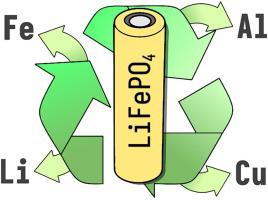当前位置:
X-MOL 学术
›
Hydrometallurgy
›
论文详情
Our official English website, www.x-mol.net, welcomes your
feedback! (Note: you will need to create a separate account there.)
The use of organophosphorus extractants as a component of hydrophobic deep eutectic solvents (HDES) for the processing of spent lithium‑iron phosphate batteries
Hydrometallurgy ( IF 4.8 ) Pub Date : 2024-07-22 , DOI: 10.1016/j.hydromet.2024.106369 Arina V. Kozhevnikova , Dmitriy V. Lobovich , Nikita A. Milevskii , Inna V. Zinov'eva , Yulia A. Zakhodyaeva , Andrey A. Voshkin
Hydrometallurgy ( IF 4.8 ) Pub Date : 2024-07-22 , DOI: 10.1016/j.hydromet.2024.106369 Arina V. Kozhevnikova , Dmitriy V. Lobovich , Nikita A. Milevskii , Inna V. Zinov'eva , Yulia A. Zakhodyaeva , Andrey A. Voshkin

|
Hydrometallurgical processes for managing industrial waste have attracted significant attention due to tightening global standards on toxic emissions. Among these processes, the use of non-volatile hydrophobic deep eutectic solvents (HDESs) has emerged as a promising approach to optimising extraction processes. In this study, HDESs incorporating tributyl phosphate (TBP) and di(2-ethylhexyl)phosphoric acid (D2EHPA) were investigated in the context of the extraction and separation of elements found in lithium‑iron phosphate batteries, including lithium, aluminium, iron and copper. The physical properties of the HDESs, such as density, viscosity and refractive index, were characterized and the interactions between their components were analysed using infrared spectroscopy. Considering the different classes of extractants represented by D2EHPA and TBP, extraction efficiency for target metals was evaluated across a range of hydrochloric acid concentrations (1–10 mol/L). Optimal conditions for re-extraction (stripping) were identified for extractant regeneration and the production of individual metal ion solutions. Results demonstrated that Fe ions could be extracted with an efficiency exceeding 99% across the majority of acidity levels, while Al ions exhibited similar efficiency from a pH of 1.4. In contrast, Cu ions showed limited extraction (<5%) at lower pH values but the level of extraction increased to 50% at pH 1.9 and above. Leveraging these findings, a sequential extraction scheme is proposed for Al, Cu, Fe and Li from their mixture, based on a gradual reduction in solution acidity.
中文翻译:

使用有机磷萃取剂作为疏水性低共熔溶剂 (HDES) 的成分来处理废磷酸铁锂电池
由于全球有毒排放标准的收紧,用于管理工业废物的湿法冶金工艺引起了广泛关注。在这些过程中,使用非挥发性疏水性低共熔溶剂 (HDES) 已成为优化萃取过程的一种有前途的方法。在这项研究中,在提取和分离磷酸铁锂电池中的元素(包括锂、铝、铁和铜。对 HDES 的物理性质(如密度、粘度和折射率)进行了表征,并使用红外光谱分析了其组分之间的相互作用。考虑到以 D2EHPA 和 TBP 为代表的不同类别萃取剂,在一系列盐酸浓度 (1–10 mol/L) 下评估目标金属的萃取效率。确定了萃取剂再生和单独金属离子溶液生产的再萃取(反萃取)的最佳条件。结果表明,在大多数酸度水平下,铁离子的提取效率都超过 99%,而铝离子在 pH 值为 1.4 时也表现出类似的效率。相比之下,Cu 离子在较低 pH 值下的萃取率有限 (<5%),但在 pH 值 1.9 及以上时,萃取率增加至 50%。利用这些发现,基于溶液酸度的逐渐降低,提出了从混合物中提取铝、铜、铁和锂的顺序提取方案。
更新日期:2024-07-22
中文翻译:

使用有机磷萃取剂作为疏水性低共熔溶剂 (HDES) 的成分来处理废磷酸铁锂电池
由于全球有毒排放标准的收紧,用于管理工业废物的湿法冶金工艺引起了广泛关注。在这些过程中,使用非挥发性疏水性低共熔溶剂 (HDES) 已成为优化萃取过程的一种有前途的方法。在这项研究中,在提取和分离磷酸铁锂电池中的元素(包括锂、铝、铁和铜。对 HDES 的物理性质(如密度、粘度和折射率)进行了表征,并使用红外光谱分析了其组分之间的相互作用。考虑到以 D2EHPA 和 TBP 为代表的不同类别萃取剂,在一系列盐酸浓度 (1–10 mol/L) 下评估目标金属的萃取效率。确定了萃取剂再生和单独金属离子溶液生产的再萃取(反萃取)的最佳条件。结果表明,在大多数酸度水平下,铁离子的提取效率都超过 99%,而铝离子在 pH 值为 1.4 时也表现出类似的效率。相比之下,Cu 离子在较低 pH 值下的萃取率有限 (<5%),但在 pH 值 1.9 及以上时,萃取率增加至 50%。利用这些发现,基于溶液酸度的逐渐降低,提出了从混合物中提取铝、铜、铁和锂的顺序提取方案。


















































 京公网安备 11010802027423号
京公网安备 11010802027423号